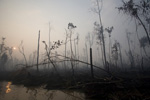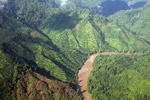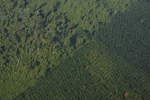Rising agricultural profitability due to higher prices, improved crop productivity, and forest conservation itself could make it increasingly difficult for conservation programs tied to payments for ecosystem services to succeed, warns a study published this week in the journal Proceedings of the National Academy of Sciences.
The prediction is based on a model that forecasts the potential impact of agricultural intensification on small farmers’ behavior in the Democratic Republic of Congo (DRC). Whereas subsistence farmers may now accept a pittance for abandoning low-yielding agriculture, in the future, higher-yields from improved genetic stock (including genetically modified crops), increased fertilizer use, and better farming practices would necessitate far higher payments to persuade farmers to keep forests standing. In other words, a program that compensated farmers based on the carbon stored in forests — like the nascent Reducing Emissions from Deforestation and Degradation (REDD+) mechanism — would have difficulty competing against increasingly industrialized agriculture.
“Our research suggests that as agriculture becomes more intensive, the small payments successful at incentivizing forest conservation today could increase to well beyond what is considered economically efficient, or even feasible,” said study lead author Jacob Phelps of the National University of Singapore. “We anticipate that similar patterns are likely across the tropics, including in places like Indonesia.”

Relationship between REDD+ policies, agricultural intensification, and deforestation. New REDD+ policies drive agricultural intensification, which increases future agricultural rents and incentivizes forest clearing for agricultural expansion. A number of feedbacks (e.g., reinvestment, in-migration) create further incentives for expansion. Whether these result in deforestation or land sparing for conservation depends on two mediating factors (1): robust forest sector governance and (2) whether REDD+ payments match future agricultural rents.
The results add weight to arguments made elsewhere. For example, Greenpeace and the Rainforest Foundation UK both cited the issue in their criticism of McKinsey’s cost curve for mitigating greenhouse gas emissions from deforestation. The activist groups said that REDD+ wouldn’t compete be able to financially with industrial activities, including large-scale commercial agriculture and mining, and thereby fail to address major drivers of deforestation. Several studies also suggested that financial returns from REDD+ would not be sufficiently high to compete with palm oil production, which is one of the most profitable forms of land use in the tropics. One paper even argued that REDD+ could undermine less yield-oriented forms of agriculture like organic farming.
In the PNAS study, Phelps and colleagues found that financial break-even points for REDD+ versus cassava and maize cultivation in DRC would require higher and higher carbon prices as crop productivity increased.
“Increasing agricultural rents are likely to incentivize future agricultural expansion, including through forest encroachment.”
Subistence agriculture like this in Suriname may be cheap to stop now, but as farming becomes more industrialized like the oil palm plantation in Borneo below, it will be increasingly costly to discourage.

The study seems to highlight the risk that while a program like REDD+ could work in the short-term while crop prices and yields are moderate, it may fail to protect forests in the long-run when prices and yields are higher. The authors add that forest conservation initiatives could even have a perverse impact if they focus on intensifying agricultural production.
“Our conceptual framework, supported by the illustrative model of the DRC, highlights how conservation policies that promote intensification anticipating automatic long-term forest conservation and emissions reductions may face unintended outcomes,” they write. “Curiously, conservation policies that promote or impose an intensification agenda on extensive farmers may actually spur future agricultural expansion.”
While illustrative, the study does come with some important caveats when evaluated on a scale beyond DRC. For one, it doesn’t directly account for the likelihood that higher profitability could encourage expansion into non-forest areas like degraded lands. Brazil and Indonesia both boast tens of millions of hectares of such lands. It also excludes the value of forest products — timber, food, and other non-wood forest products — that might continue to be available to local communities under REDD+ programs. Nor does it factor in potential payments for other ecosystem services (PES) like water and biodiversity. Nonetheless the research does raise significant points of consideration for the design of REDD+ and other PES schemes.
“Conservation policies that overlook future agricultural rents may fail to promote long-term conservation,” the authors write. “While our model was illustrative, rather than predictive … it highlights the possible impacts of agricultural intensification to long-term tenability of conservation incentives such as REDD+, and highlights under-investigated issues such as the importance of recurring conservation incentives and viability of financial versus nonfinancial incentives.”
CITATION: Jacob Phelps et al. Agricultural intensification escalates future conservation costs. Proceedings of the National Academy of Sciences for the week of April 15, 2013. www.pnas.org/cgi/doi/10.1073/pnas.1220070110
Related articles
Agriculture causes 80% of tropical deforestation

(09/27/2012) Agriculture is the direct driver of roughly 80 percent of tropical deforestation, while logging is the biggest single driver of forest degradation, says a new report funded by the British and Norwegian governments. The report presents an overview of drivers of deforestation to inform policymakers involved in developing the REDD+ mechanism, an international program that aims to reduce emissions from deforestation and forest degradation.
Forest protection plans failing to address food needs
(06/08/2011) Strategy plans for implementing programs to reduce emissions from deforestation and forest degradation (REDD) are failing to provide details on how they will address forest conversion for agriculture, which in most countries is a major driver of deforestation, argues a new report from the CGIAR Research Program on Climate Change, Agriculture and Food Security (CCAFS) and Lexeme Consulting.
Study calls for REDD+ money to boost yields in West Africa using agrochemicals
(04/10/2011) Small-scale agriculture including cocoa, cassava, and oil palm farming has driven large-scale conversion West Africa tropical forests, reports new research published in the journal Environmental Management.
Greenpeace says McKinsey’s REDD+ work could encourage deforestation

(04/07/2011) One of the world’s top consultancies, McKinsey & Co., is providing advice to governments developing ‘Reducing Emissions from Deforestation and Degradation’ (REDD+) programs that could increase risks to tropical forests, claims a new report published by Greenpeace. The report, Bad Influence – how McKinsey-inspired plans lead to rainforest destruction, says that McKinsey’s REDD+ cost curve and baseline scenarios are being used to justify expansion of industrial capacity in Indonesia, Papua New Guinea, Democratic Republic of Congo, and Guyana.
Greening the world with palm oil?

(01/26/2011) The commercial shows a typical office setting. A worker sits drearily at a desk, shredding papers and watching minutes tick by on the clock. When his break comes, he takes out a Nestle KitKat bar. As he tears into the package, the viewer, but not the office worker, notices something is amiss—what should be chocolate has been replaced by the dark hairy finger of an orangutan. With the jarring crunch of teeth breaking through bone, the worker bites into the “bar.” Drops of blood fall on the keyboard and run down his face. His officemates stare, horrified. The advertisement cuts to a solitary tree standing amid a deforested landscape. A chainsaw whines. The message: Palm oil—an ingredient in many Nestle products—is killing orangutans by destroying their habitat, the rainforests of Borneo and Sumatra.
Converting palm oil companies from forest destroyers into forest protectors

(01/02/2011) In efforts to save the world’s remaining rainforests great hopes have been pinned on “degraded lands” — deforested lands that are presently sitting idle in tropical countries. Optimists say shifting agriculture to such lands will help humanity produce enough food to meet growing demand without sacrificing forests and biodiversity and exacerbating social conflict. But to date, degraded lands remain an enigma, especially in Indonesia, where deforestation continues at a rapid pace. Degraded lands are often misclassified by various Indonesian ministries—land in a far-off province may be listed as “wasteland” by Jakarta, but in reality is blanked by verdant forest that sequesters carbon, houses wildlife, and affords communities with food, water, and other essentials. Granting logging and plantation concessions on these lands can result in conflict and environmental degradation.
Could forest conservation payments undermine organic agriculture?
(09/07/2010) Forest carbon payment programs like the proposed reducing emissions from deforestation and degradation (REDD) mechanism could put pressure on wildlife-friendly farming techniques by increasing the need to intensify agricultural production, warns a paper published this June in Conservation Biology. The paper, written by Jaboury Ghazoul and Lian Pin Koh of ETH Zurich and myself in September 2009, posits that by increasing the opportunity cost of conversion of forest land for agriculture, REDD will potentially constrain the amount of land available to meet growing demand for food. Because organic agriculture and other biodiversity-friendly farming practices generally have lower yields than industrial agriculture, REDD will therefore encourage a shift toward from more productive forms of food production.
80% of tropical agricultural expansion between 1980-2000 came at expense of forests

(09/02/2010) More than 80 percent of agricultural expansion in the tropics between 1980 and 2000 came at the expense of forests, reports research published last week in the early online edition of the Proceedings of the National Academy of Sciences (PNAS). The study, based on analysis satellite images collected by the United Nations Food and Agricultural Organization (FAO) and led by Holly Gibbs of Stanford University, found that 55 percent of new agricultural land came at the expense of intact forests, while 28 percent came from disturbed forests. Another six percent came from shrub lands.







